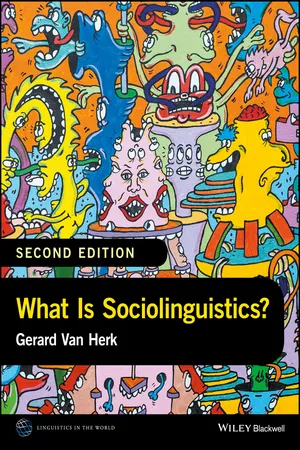
- English
- ePUB (mobile friendly)
- Available on iOS & Android
What Is Sociolinguistics?
About this book
How is our language affected by our ethnicity, gender, and region? How are our conversations and other interactions structured? How does society view and regulate language? How do we use language to present ourselves to others? In this revised and updated second edition of the popular What Is Sociolinguistics? Gerard Van Herk explores these and other intriguing questions about language, how we use it, and its relationships to society. Van Herk guides the reader on a tour through the major issues that define the field, including region, status, gender, time, language attitudes, interaction, and style, at the same time exploring the sociolinguistics of multilingualism, culture and ethnicity, language contact, and education.
This second edition has been revised and updated to include new and more exercises, discussion questions, and suggested readings, as well as expanded chapters exploring gender duality and Latino English. Key readings are introduced in Van Herk's clear and engaging voice, which accompanies the text throughout, providing an accessible point of entry for those new to, or less familiar with, sociolinguistics. Chapter summaries and textboxes are similarly employed to signpost and illuminate learning. A companion website features PowerPoint slides for each chapter with suggestions for framing class discussions and exercises, further examples of concepts discussed, additional reading suggestions, and ready-to-go slides for class presentation.
Packed with the latest research and practical teaching aids, What is Sociolinguistics? Second edition retains the highly-praised character of its predecessor and provides an essential up-to-date text for both students and instructors alike.
Frequently asked questions
- Essential is ideal for learners and professionals who enjoy exploring a wide range of subjects. Access the Essential Library with 800,000+ trusted titles and best-sellers across business, personal growth, and the humanities. Includes unlimited reading time and Standard Read Aloud voice.
- Complete: Perfect for advanced learners and researchers needing full, unrestricted access. Unlock 1.4M+ books across hundreds of subjects, including academic and specialized titles. The Complete Plan also includes advanced features like Premium Read Aloud and Research Assistant.
Please note we cannot support devices running on iOS 13 and Android 7 or earlier. Learn more about using the app.
Information
1
Introduction
In this chapter:
- Types of sociolinguistics
- The background of the discipline
- Personalizing sociolinguistics
- Getting the most out of this book
types of sociolinguistics
background: the history of sociolinguistics
Table of contents
- Cover
- Title Page
- Table of Contents
- Acknowledgments
- About the Companion Website
- 1 Introduction
- 2 Language and Society
- 3 Place
- 4 Social Status
- 5 Time
- 6 Ethnicity
- 7 Gender
- Interlude
- 8 Style
- 9 Interaction
- 10 Multilingualism
- 11 Language Contact
- 12 Attitudes and Ideologies
- 13 Language as a Social Entity
- 14 Education
- Epilogue. What is Sociolinguistics?
- Glossary
- Bibliography
- Index
- End User License Agreement